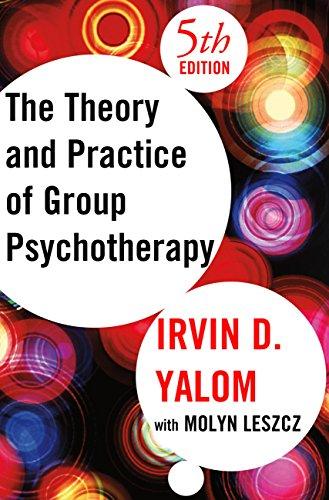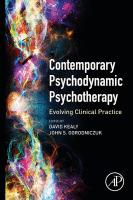PsychodynamicGroupPsychotherapy,FifthEdition 5thEdition,(EbookPDF)

https://ebookmass.com/product/psychodynamic-grouppsychotherapy-fifth-edition-5th-edition-ebook-pdf/

Instant digital products (PDF, ePub, MOBI) ready for you
Download now and discover formats that fit your needs...
The Theory and Practice of Group Psychotherapy 5th Edition, (Ebook PDF)
https://ebookmass.com/product/the-theory-and-practice-of-grouppsychotherapy-5th-edition-ebook-pdf/
ebookmass.com
Contemporary Psychodynamic Psychotherapy: Evolving Clinical Practice David Kealy
https://ebookmass.com/product/contemporary-psychodynamicpsychotherapy-evolving-clinical-practice-david-kealy/
ebookmass.com
Group Dynamics for Teams 5th Edition, (Ebook PDF)


https://ebookmass.com/product/group-dynamics-for-teams-5th-editionebook-pdf/
ebookmass.com
The Sociology of Time: A Critical Overview Ji■í Šubrt

https://ebookmass.com/product/the-sociology-of-time-a-criticaloverview-jiri-subrt/
ebookmass.com

https://ebookmass.com/product/radiant-sin-katee-robert-6/
ebookmass.com
Maderu2019s Understanding Human Anatomy & Physiology (Maderu2019s Understanding Human Anatomy and Physiology) 9th Edition, (Ebook PDF)
https://ebookmass.com/product/maders-understanding-human-anatomyphysiology-maders-understanding-human-anatomy-and-physiology-9thedition-ebook-pdf/ ebookmass.com
Belisarius & Antonina: Love and War in the Age of Justinian David Alan Parnell
https://ebookmass.com/product/belisarius-antonina-love-and-war-in-theage-of-justinian-david-alan-parnell/
ebookmass.com
Global Health, Humanity and the COVID-19 Pandemic: Philosophical and Sociological Challenges and Imperatives Francis Egbokhare
https://ebookmass.com/product/global-health-humanity-and-thecovid-19-pandemic-philosophical-and-sociological-challenges-andimperatives-francis-egbokhare/ ebookmass.com
Popular World Music, 2nd Edition u2013 Ebook PDF Version




https://ebookmass.com/product/popular-world-music-2nd-edition-ebookpdf-version/
ebookmass.com

McGraw-Hill Education Conquering the SAT Writing and Language Test and SAT Essay, Third Edition Christopher Black
https://ebookmass.com/product/mcgraw-hill-education-conquering-thesat-writing-and-language-test-and-sat-essay-third-edition-christopherblack/ ebookmass.com

e agents of change in dynamic group therapy include not only the therapist and the individual patient and the intrapsychic changes that can occur from impactful interpretations, but also the exchanges among members that offer corrective and mutative interpersonal experiences for the group members. is is well stated by Stern et al. (1998), experts in the study of interpersonal relationships starting in infancy, who speak about the individual therapy process:
Anecdotal evidence suggests that aer most patients have completed a successful treatment they tend to remember two kinds of nodal events they believe changed them One concerns the key interpretations that rearranged their intrapsychic landscape e other concerns special moments of authentic person to person connection with the therapist that altered the relationship with him or her and thereby the patient’s sense of self (p 904)
ese comments can be readily mapped onto the psychodynamic group therapy process in which moments of authentic person-to-person connection as well as interpretive moments are available in great supply.
We also suggest that these moments of change affect not only understanding, experience, and behavior, but indeed neurobiology. ere is a whole new field of social neuroscience, which focuses exclusively on the interaction between biological processes and human behavior and relatedness (see Decety & Cacioppo, 2011; Harmon-Jones & Winkielman, 2007). For example, Rilling et al. (2002) studied cooperation and altruism and found that cooperation resulted in a measurable increase in brain activity in the section of the brain having to do with rewards. Both the increasing evidence that psychodynamic therapy works and has lasting benefits for patients, and the growing recognition that relationships are not only important for healing but necessary for a full life, mean that psychodynamic group therapy is increasingly seen as an especially viable and powerful modality.
e exponential growth of virtual social networks speaks to the hungering for relatedness in today’s world. It may also be argued that the virtual nature of those networks also speaks to some anxieties about having “real” relationships. Group therapy as a modality is perfectly positioned to both satiate the hunger and relieve the anxiety.
Much is new in this edition. e initial edition of this volume was among the first to focus on interpersonal factors as the central healing forces in all psychotherapy, especially in group psychotherapy. e growing emphasis on interpersonal models of psychotherapy, sometimes called relational models, can be seen as an extension of that focus. We continue to enhance that focus and incorporate the latest modifications to psychodynamic and interpersonal theory as they apply to group therapy. We also include the latest contributions from research into the effectiveness of group therapy and from the rapidly increasing knowledge about how our neurobiology impacts our mental health.
Moreover, we offer an entirely new clinical vignette in Chapter 13, with a thoroughgoing analysis by all three authors. is discussion highlights different approaches within the psychodynamic tradition. We have also included many new issues in Chapter 17 as well as keeping current with the literature, including over 25% more references than in the fourth edition.
We hope you will find this latest edition useful in your practice as group therapists.
J. SCOTT RUTAN
WALTER N. STONE
JOSEPH J. SHAY
Title Page
Copyright Page
About the Authors
Preface
Acknowledgments
1. Groups in Today’s Society
2. History of Small-Group eory and Practice
3. Group Dynamics and Group Development
4. erapeutic Factors in Group Psychotherapy
5. Mechanisms and Processes of Change
6. Forming a Group
7. Patient Selection
8. Patient Preparation and the Group Agreements
9. e Role of the Group erapist
10. Beginning the Group
11. Special Leadership Issues
12. Expressions of Affect in Group Psychotherapy
13. e erapeutic Process: A Clinical Illustration
14. Difficult Groups and Difficult Patients
15. Time-Limited Psychodynamic Groups
16. Termination in Group Psychotherapy
17. Frequently Asked Questions
References
Author Index
Subject Index
About Guilford Press
Discover Related Guilford Books
Groups in Today’s Society
We allow our ignorance to prevail upon us and make us think we can survive alone, alone in patches, alone in groups, alone in races, even alone in genders
MAYA ANGELOU
Human beings are essentially herd animals. We begin in small groups our families and live, work, and play in various groups. e formation of our personalities is predicated upon our experiences with the different groups in which we interact, and the opportunities for modification and change of our personalities are very much affected by the groups in which we are involved. As Harry Stack Sullivan (1953a) maintained, it takes people to make people sick, and it takes people to make people well again.
Since the first edition of this book appeared in 1984, a striking change has occurred in the world of groups. Could anyone have even imagined at that time making a stark statement such as this?: Personal groups are on the precipice of being replaced by virtual groups. Scott Adams, in a Dilbert cartoon, noted, “When virtual reality gets cheaper than dating, society is doomed.” Although the quest to belong is evident in the vast increase in social networks such as Facebook, LinkedIn, and Twitter, one has only to read such insightful works as those by Turkle (2011) or Carr (2011) to wonder at the profound price being paid for these changes. Slater (2013), in an in-depth exploration of the effect of technology on meeting and mating, makes the case that the technological path to dating is adversely affecting authenticity in relationships. Commenting on Slater’s work, Young (2013) suggests his conclusion is that, rather than enhancing the dating experience,
online dating and other technologies are actually contributing to “making people less authentic, more deceptive, less committed, quickly intimate, more paranoid, less sexually discerning, and less trusting” (p. 1). (Young also notes that Slater’s parents were among the first to have met online, and the fact that they separated when he was 3 might have influenced his judgment on the matter.)
CULTURE AND MENTAL ILLNESS
e psychopathologies confronting modern clinicians differ from those that confronted Sigmund Freud and his colleagues. Freud (1914/1958) analyzed the pathologies of the members of the society in which he lived, and through that examination made revolutionary discoveries about the formation and complexion of personality. e pathology that most fascinated Freud was hysteria; this disorder became the lens through which he focused his conceptions of individual psychodynamics.
In contemporary society, classical hysteria is not the pathology around which theory is formed. e cutting edge of modern psychodynamic thought focuses on character disorders, especially narcissistic and borderline conditions, and attachment disorders. In these and similar clinical presentations, pathology is manifest in the disturbed quality of relationships with others. We maintain that each of these specific diagnoses may be a different way of coping with difficulties in gaining and sustaining viable relationships.
ese “ new ” pathologies have been accompanied by other post-Freudian developments in our understanding of psychopathology and in our practice of psychotherapy. Giovacchini (1979) observed that as psychoanalysis began to treat character-disordered patients, this “shied our focus from a predominantly id-oriented psychology to an ego psychology. . . . It highlighted the importance of early development. e subtleties and vicissitudes of early object relationships have assumed paramount importance” (p. 3). Moreover, the practice of psychodynamic psychotherapy
has moved toward adopting an intersubjective approach to the therapy process in which the therapist is viewed more as an active participant than simply an expert expounding interpretations.
e etiology of psychopathology is multidetermined. Elements of genetics, biology, and temperament go into the human experience, along with the intrapsychic and interpersonal forces that are the province of psychodynamic theories. Unfortunately, most theory and research focus on one side of this interactive axis rather than trying to understand how these forces interrelate. Current research demonstrates just how powerful psychodynamic treatment can be (see Shedler, 2010).
e search for a link between cultural factors and mental illness began as early as 1897, when Emile Durkheim (1897/1951) wondered about the connection between suicide and social conditions. In 1939 Faris and Dunham suggested a causal relationship between schizophrenia and the living conditions in Chicago slums. Leighton (1959), in his well-known Stirling County (Nova Scotia) study, discovered an overall correlation between mental illness and social disarray, as well as correlations between specific sociocultural settings and particular types of psychiatric disorder. Several clinical syndromes, such as koro, latah, and amok, are clearly culture bound (Leff, 1988). Koro, for example, is the strange syndrome in which there is a belief that a man ’ s penis will disappear into his body, and relatives are prepared to take action to prevent this from occurring. At times this belief has reached epidemic proportions in native populations. Dohrenwend and Dohrenwend (1974) found that although schizophrenia seems to be present in all cultures, there is considerable discrepancy in the types of schizophrenia that dominate in different cultures. Likewise, Cohen (1961) demonstrated the presence of cultural factors in the etiology of depressive reactions, and Kleinman and colleagues (Kleinman, 1980, 1988; Kleinman, Das, & Lock, 1997) highlighted the profound interpenetration of culture and psychiatric conditions.
us, the notion that there is a connection between cultural factors and the formation and expression of mental disorder has already been examined in some depth. For our purposes, that cultures and eras have their characteristic and dominant pathologies is of particular relevance. In the
modern world, for example, there is evidence that individuals have difficulty obtaining and sustaining intimate interpersonal relationships. Ours is a culture that emphasizes individual gratification.
EARLY VICTORIAN CULTURE
e early Victorian era was both stressful and comforting to people in specific ways. Victorian society offered far fewer choices than does current Western society. Although it was vastly more open than societies that preceded it, members of Victorian culture were, nevertheless, born into roles largely determined by class, church, ethnicity, and gender. Because there was little opportunity to go beyond those roles, the individual’s hopes and aspirations were oen sources of frustration. On the other hand, individuals were spared the burden of ambiguity and choice. Acceptable behavior was highly codified, typically by a strong church morality, with the result that sexual and aggressive drives, in particular, were restricted. Exceptions exist, of course. For example, the presence of a vigorous body of Victorian pornographic literature suggests that sexual drives were not thwarted altogether.
In Victorian society, individuals had a definite place, though not necessarily a place they chose or relished. Concomitantly, individuals had a clear identity. Relationships were set within the framework of the nuclear family, the extended family, the neighborhood, the world of work, and the church, all of which provided most people with natural sources of support and stability.
Individuals in Victorian times were presented with fewer choices about how to live their lives and with whom to live them. is is not to imply that there was an absence of frustration and pain. If few complained about being “bent out of shape,” it was only because being shaped was so universal. It is reasonable to assume that the restrictiveness of that society might have led to pathologies that expressed conflict between individuals’ powerful innate impulses and the introjects of a superego-ridden society.
Do we psychotherapists see patients like Anna O or Emma von N in our offices today? Probably not, unless we work in highly contained ethnic communities where the role of nuclear family, extended family, neighborhood, and church still hold sway. When these patients do appear, they oen come to our colleagues in neurology or internal medicine. at the types of psychopathology present in our society are different from those observed by Freud suggests a powerful correlation between society and mental illness.
Freud not only observed the patients of his day, he observed them within the framework of that society. People in the Victorian era had a conviction that “structure” could harness the very forces of nature. is belief in the ultimate dependability of matter led to unprecedented productivity, wealth, and hegemony over peoples of a more “primitive” nature around the world. It is little wonder that Freud began to hypothesize about the “parts” that make up personality his theory fit comfortably with the science of the era.
In the intervening years, more modern psychodynamic theories began to refer not so much to faulty parts as to dysfunctional relationships and dissatisfying ways of living. Modern concepts of pathology are cast less about mismatched or improperly fitting parts than about disrupted developmental processes. However, in the current atmosphere, there is a press to return to a more Victorian approach of understanding our patients as “broken,” suffering from a specific and discrete illness for which there is, presumably, a specific and discrete treatment. (We are not referring here to the significant advances in theory brought by the internal family systems model [Schwartz, 1995], which emphasizes the struggle for hegemony of the various parts of the personality.)
Whereas current psychodynamic theorists chart the evolution of personality through social systems, Freud viewed the ego as essentially the product of intrapsychic conflict. ough individual personality was understood to be affected by interactions with significant others (especially the mother), it was nonetheless not seen as predominantly formed in those interactions. Rather, personality was understood to be the result of a thoroughly inward process. e ego was conceptualized as a rational, unemotional arbiter between the instinctual urges common to all people
working for and investing in the future has been diminished, and most modern individuals “live for today.” In recent years, fears about the shakiness of the historically trustworthy safety net of Medicare and Social Security may have added to this focus. If Victorian culture provided stability at the cost of choices, in modern culture individuals are confronted with a bewildering array of choices (Brown, 2002). Along with choices come ambiguity and uncertainty. If Victorian culture provided secure but restrictive relationships at the price of internal conflict, modern society underestimates the importance of maintaining and sustaining relationships.
MODERN PSYCHOPATHOLOGY
Although in the psychodynamic world there is increasing emphasis on the importance of relationships in the etiology and the healing of psychopathology, in today’s world there is another school that understands mental illness in purely biological terms. omas Insel, MD (2011), Director of the National Institute of Mental Health, lecturing at the 164th annual meeting of the American Psychiatric Association, said:
It’s time to fundamentally rethink mental illness Psychiatric research today promises to produce a true science of the brain. . . . Mental disorders are brain disorders. . . . What is emerging today is a picture of mental illness as the result of a pathophysiological chain from genes to cells to distributive systems within the brain, based on a patient’s unique genetic variation. . . . With a true science of mental illness from genes, to cells, to brain circuits, to behavior psychiatrists will be able to better predict who is likely to develop a mental disorder and to intervene earlier. Once that happens, we will be in a different world.
e perspective from which we write this book does not reject this idea for we, too, believe that neuroscience has a great deal to offer in understanding the substrate of psychological distress and psychiatric illness. Even if we agree, though, that the brain and the body are involved in essentially everything, we do not believe that every visit to a therapist or a group therapist is for a “mental disorder” or “mental illness,” even if the “disorder” is described in some version of the DSM. Our focus on psychopathology and psychological well-being is much broader and is directed not only
toward the reduction of suffering that attends a biologically based illness but also to improving the ability of individuals to engage in healthier and more gratifying interactions when they have been unable to do so.
In this context, we maintain that the ability to enter into cooperative, loving, interdependent relationships has always been a sign of psychological maturity and health. is is particularly so today. Indeed, one quick but accurate indicator of mental health is the degree to which individuals allow themselves to know how important others are to them. Conversely, feeling excluded is not only an emotionally painful experience, it can have neurobiological consequences. Ijzerman and Saddlemeyer (2012) report:
A number of research groups, including labs in Canada, Poland and our own in the Netherlands, have reported that having the memory of being socially excluded or just feeling “different” from others in a room is enough to change our perception of the environment around us Such feelings can prime individuals to sense, for example, that a room in which they’re standing is significantly colder than it is (p 12)
Given the changes that have occurred in the world since Freud’s time, it is quite understandable that the stereotypical pathologies of today involve the ability to effect, experience, and enjoy intimate and sustaining relationships. Consequently, the psychopathologies that confront modern clinicians, many of which have attachment issues at their core, are character disorders (such as borderline and narcissistic personalities) and mood disorders (such as depression and anxiety). ese conditions can be understood as relational problems. e borderline patient is too aware of the importance of others, whereas the narcissistic patient appears incapable of knowing how important others are. Depression and anxiety can both be understood as adaptive responses to the terrors of intimacy. Fairbairn (1952a) was among the first to state that it is the relationship with the object (another), not the gratification of an impulse or drive, that is the fundamental fact of human existence. It is as though modern patients do not disable physical “parts” of themselves, as did Freud’s patients, so much as they disable their relationships (Kernberg, 1976) and cannot adequately relate to others (Havens, 1996; Kohut, 1971).
